Mercedes-Benz Citan van review (2024)
An appealing small van let down by its limited loading capacity
PROS
- Feels high quality throughout
- Good spread of engine options
- Comfortable and easy to drive
- At least six airbags as standard
CONS
- Engines can be noisy
- Rivals offer higher payload
- Smaller than average load space
- Taller drivers may feel cramped
Summary
The latest generation of the Mercedes-Benz Citan is the second to bear the name, but it represents a huge leap on from the previous version, and is now one of the best small vans in the class. We've driven several examples of this all-new small van in order to bring you this full review.
Once again, the Mercedes Citan is based on the Renault Kangoo. But this time, not only does the transformation go far deeper than before, Mercedes has been much more actively involved in engineering the vehicle from the start.
As a result, you’ll not only find that it looks very much in keeping with every other modern Mercedes product – be that vans like the Vito and Sprinter or cars such as the A-Class and C-Class – it also feels more substantially like a high-quality product from the moment you get in and start driving.
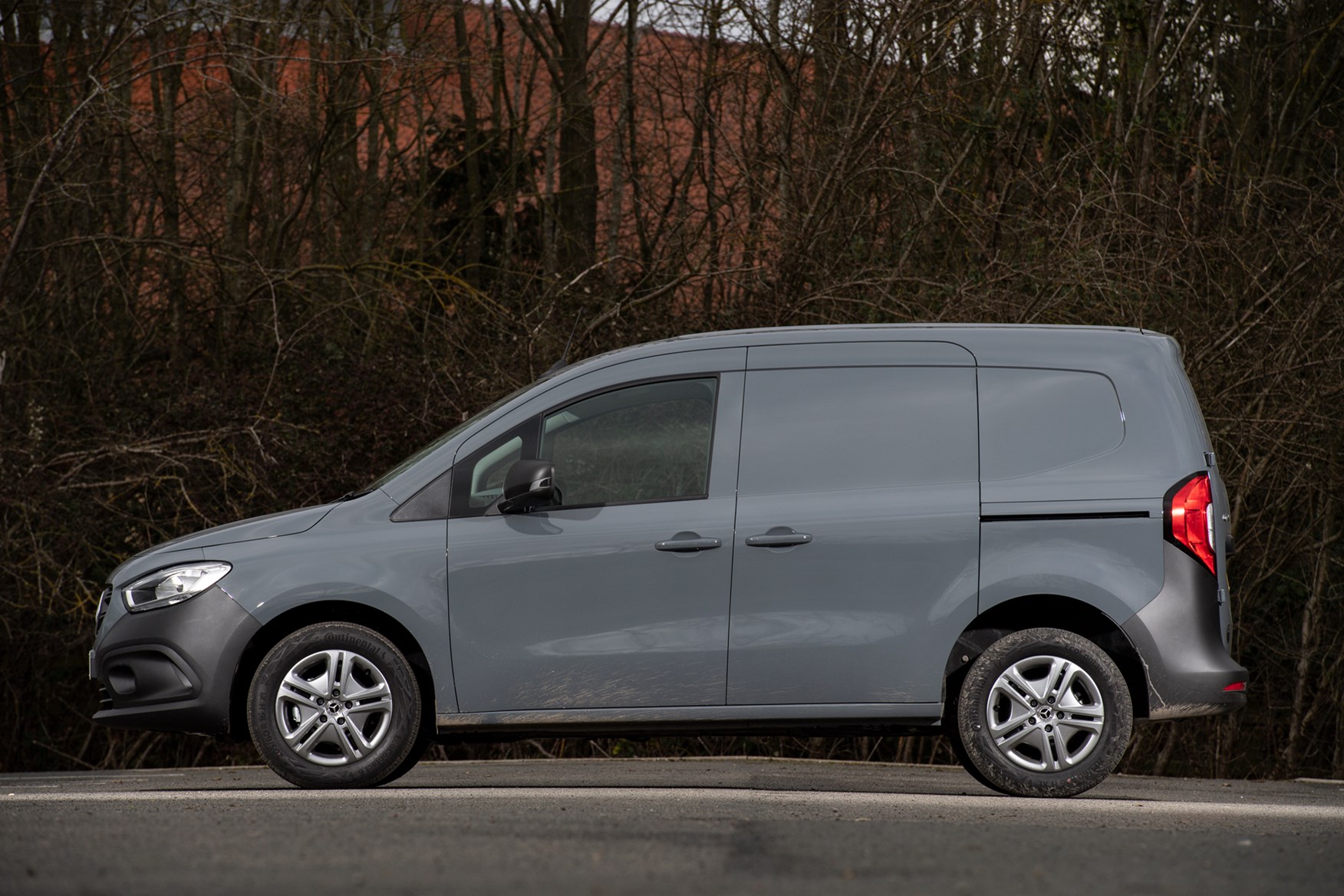
Featuring a completely changed dashboard and Mercedes’ own MBUX infotainment system, you’ll have to look fairly hard to find any visibly shared parts at all. What’s more, as we know from having driven the latest diesel and all electric Renault Kangoo E-Tech already, the quality of that small van has also been raised considerably.
Mercedes Citan variants and engine choices
While we’ve so far only been able to drive the standard short-wheelbase model, the Citan will be available as a long-wheelbase small van as well.
It’s also offered as the Citan Tourer passenger vehicle as well as a standard panel van – we’ve driven both here – and it forms the basis of the new Mercedes T-Class car, too.
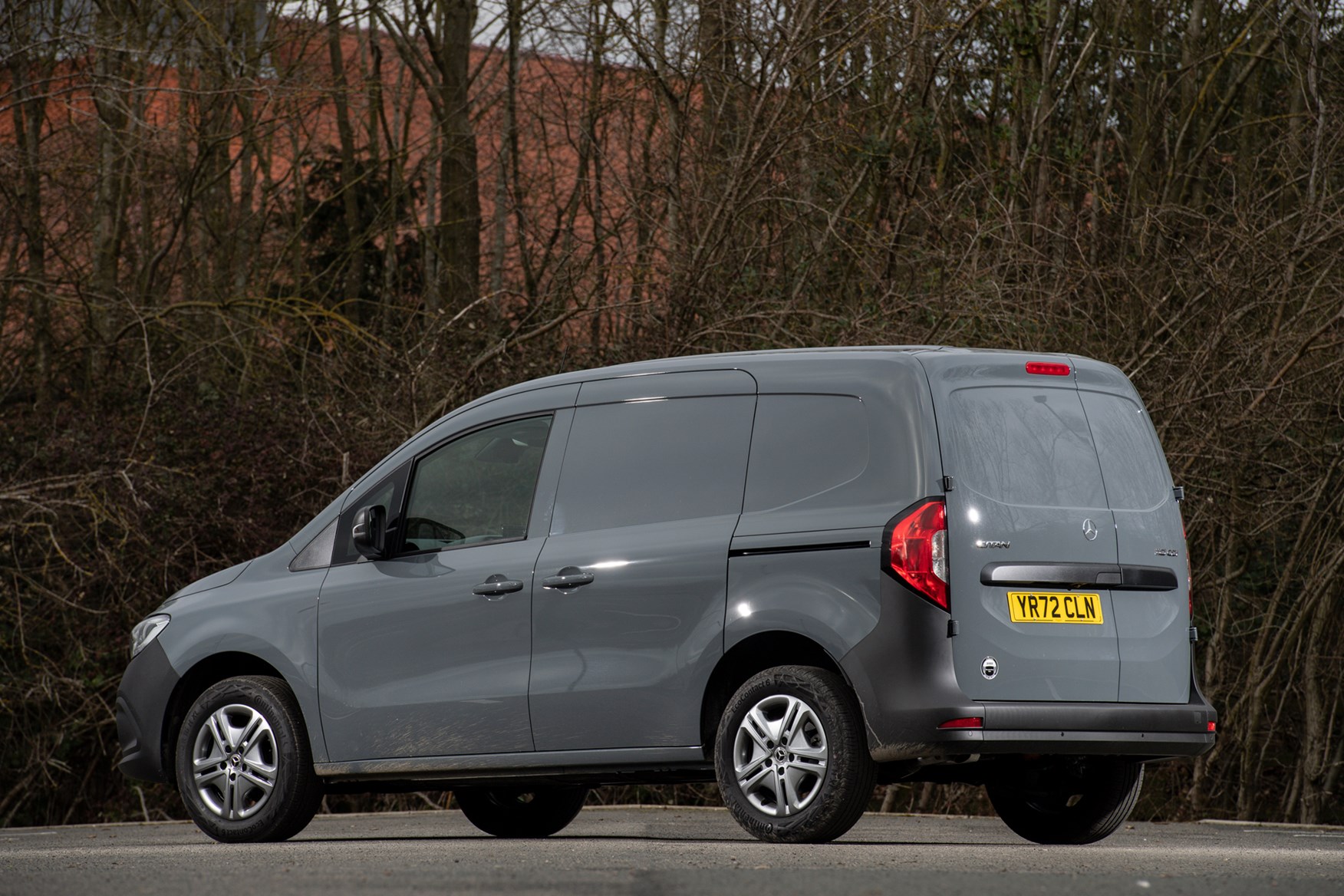
Mercedes offers the Citan with petrol and diesel engines ranging from 75hp to 131hp in other markets, though at the moment just the one, 95hp, option will be available to UK buyers. This might well change in the future, should the demand be there - Renault and Nissan both feature a petrol version of their equivalent van after all.
However, we will also get the Mercedes e-Citan electric van, which we have covered in a separate review.
Check out our dedicated Mercedes-Benz Citan dimensions page for full details of load area, towing capacity and payload.
Mercedes Citan rivals
Payload and practicality is worth considering a little further here, though. The Citan’s maximum of 827kg (including 75kg for the driver) falls some way short of the 1,000kg payload ratings available from the best small vans.
These include the multiple Parkers Award-winning family of vans, the Citroen Berlingo, Peugeot Partner, Vauxhall Combo Cargo and – 2023 Parkers Small Van of The Year – the Toyota Proace City.
What’s more, the short-wheelbase Citan’s maximum load volume is just 2.9 cubic metres – making the load space far smaller than the above rivals’ 3.3 cubic metre minimum.
In image terms, the Citan’s closest rival remains the VW Caddy Cargo, and this is another very car-like van. And don’t dismiss older rivals such as the Ford Transit Connect, which remains a very high quality small van.
Verdict: is the 2024 Mercedes-Benz Citan any good?
This review goes into much greater detail about the 2024 Citan if you keep reading. But if you need a quick verdict, we find the Citan leaves us feeling rather mixed.
On one hand, it's good to drive and comfortable. The cab interior is in with a shout of being the best in the sector, the safety equipment is fantastic and the running costs are looking competitive.
On the other hand, the load space is very small and the payload ratings merely ok compared with other vans of this size. Judging by the Renault Kangoo, the L2 version should help on these fronts though.
So consider your priorities carefully before you get carried away with the Mercedes-Benz image. The Citan is quite an appealing thing, but it certainly isn't the most practical small van on the market.
Skip to our full verdict on...
- Wide choice of petrol and diesel power
- Comfortable and good to drive
- Engines can be noisy, however
The new Citan is available with five conventional engine options, two petrol and three diesel. However, only the mid-level diesel is offered in the UK at launch. Here's what it's like to drive.
Mercedes Citan engine options
The diesels are all based around the same basic 1.5-litre turbo, and come with the following power outputs:
- Citan 108 CDI: 75hp at 3,750rpm / 230Nm at 1,750rpm
- Citan 110 CDI: 95hp at 3,750rpm / 260Nm at 1,750rpm
- Citan 112 CDI: 116hp at 3,750rpm / 270Nm at 1,750rpm
Similarly, the petrols are both based on the same 1.3-litre turbo engine, with power output adjusted to give buyers the choice of:
- Citan 110: 102hp at 4,500rpm / 200Nm at 1,500rpm
- Citan 113: 131hp at 4,500rpm / 240Nm at 1,600rpm
It’s not yet clear whether more engine options will be offered to Citan customers in the UK in the future - the Kangoo comes with the higher powered diesel and the lower powered of the two petrols for example. At this stage we have driven all but the entry-level 75hp diesel, sampled across a variety of panel van and Tourer models.
What are the Citan’s engines like?
The diesels are likely to be the bigger sellers, and it’s the mid-ranking 110 CDI with 95hp that probably makes the most sense to most buyers, which explains why Mercedes has put all its eggs in this basket. Its 260Nm of torque is only just shy of the 270Nm provided by the 112 CDI.
When shifting loads, torque is more important than horsepower, so don’t feel you are missing out on that higher 116hp figure unless you’re planning to wring the engine out at every possible opportunity (in which instance the 112 CDI does manage to go 0-62mph some 2.1 seconds faster than the 13.8 seconds the 110 CDI can manage).
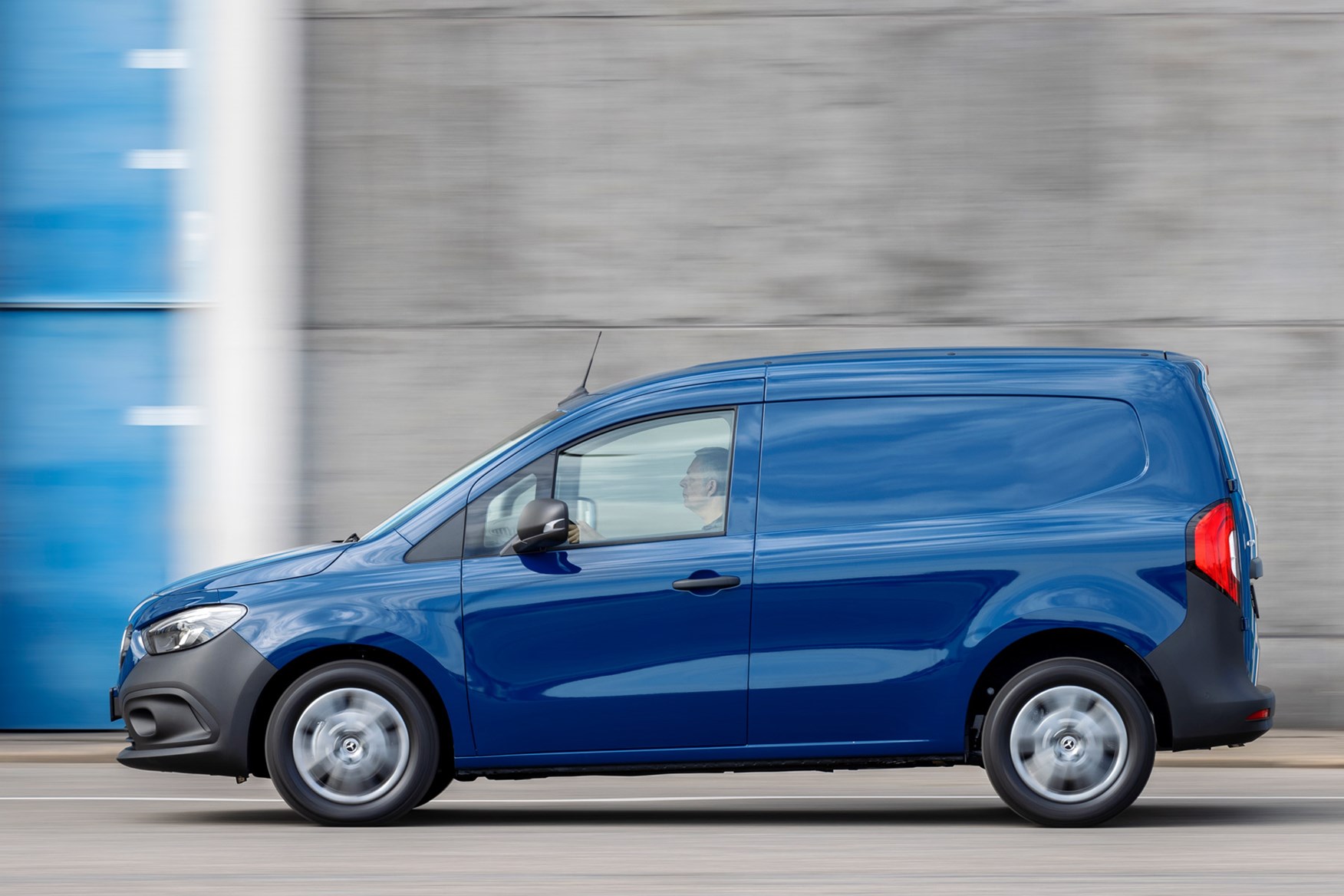
Neither diesel variant is likely to encourage that kind of behaviour, as once you get much higher than 2,000rpm they get very loud. This is worse in the panel van than in the Tourer, which is generally quieter and more refined, but a surprise for a modern van in either case – especially as the Citan is otherwise impressively refined.
In fact, with little road or wind noise, it’s exactly the opposite to the Volkswagen Caddy Cargo. The Citan’s diesels are noisy compared with the Caddy’s much quieter ones, but the Mercedes’ cabin is generally quieter than the boomy, resonant experience you get across a wider range of speeds in the VW.
You can drive around the engine noise in the Citan more easily than you can avoid the boominess in the Caddy, however – if anything it’s a reminder to change up a gear, because the little Mercedes is quite happy to tickle along in sixth at very low rpm.
The petrol versions won’t be as economical on longer journeys, although around town they could prove less painful to run than the diesel engines (modern diesels don’t like short trips) and they both offer plenty of torque at low rpm – traditionally a weak point of petrol versus diesel. It's worth waiting to see if the Citan comes with one, although both the Kangoo and the Nissan Townstar, which is the third van in the partnership, will offer petrol engines.
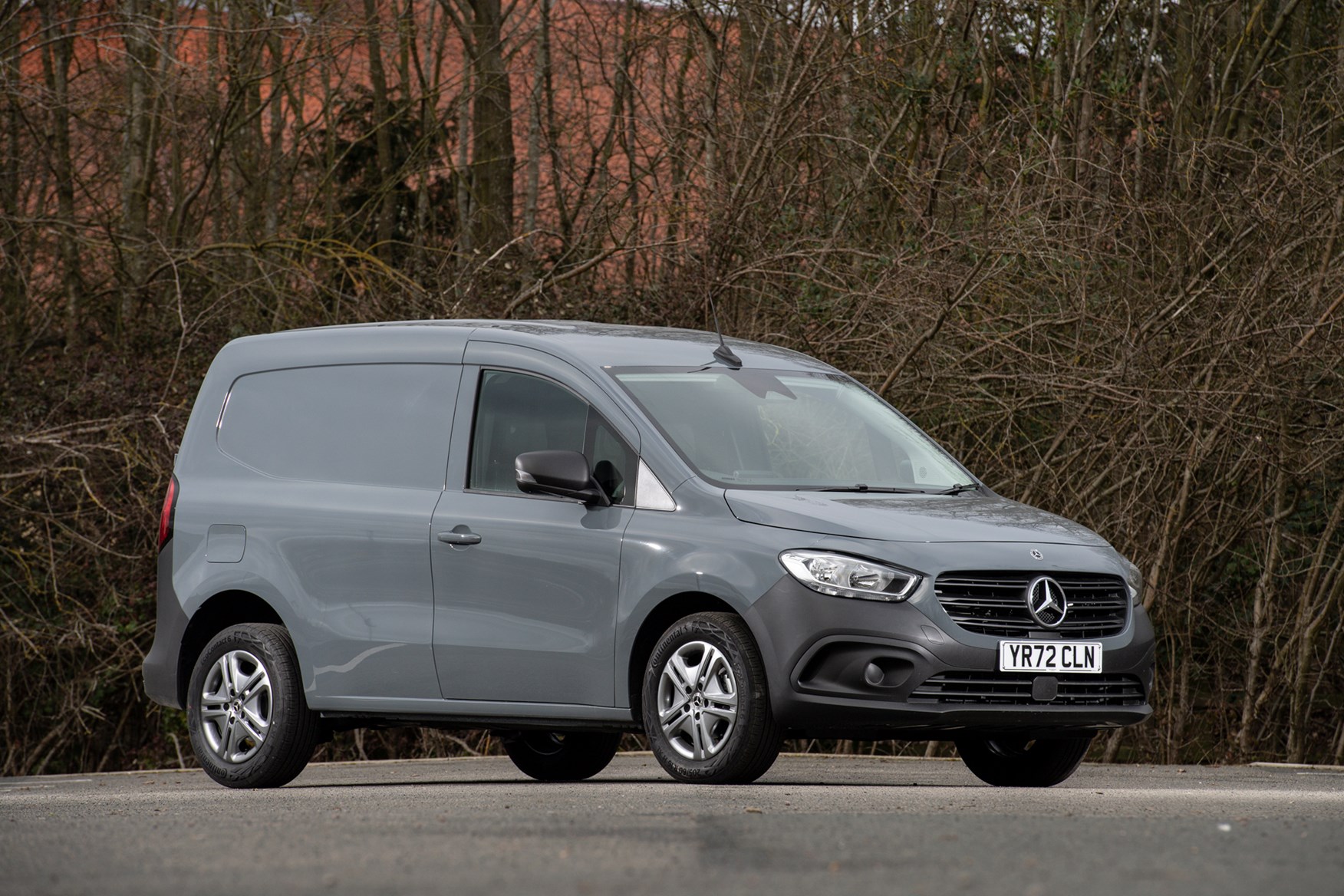
These engines also suffer with some surprising resonance at certain points in the rev range – and they certainly don’t encourage you to rev the nuts off them. But even when this is happening they’re quieter and less uncomfortable to listen to.
Regardless of engine type, all Citans come with a six-speed manual gearbox as standard, with a snappy, mechanically precise-feeling action. A seven-speed dual-clutch automatic transmission option will be available on more powerful engines at launch.
Cornering and comfort
The Citan’s steering is fairly numb and lifeless, which means you’re left assuming there’s plenty of grip at the driven front wheels rather than really feeling it. It’s also particularly light in the petrol-powered models, which takes a little bit of getting used to, but ultimately makes it easy to whizz around in the city and beyond; the diesels feel heavier, but not so much so that they are likely to become tiring to drive.
On the plus side, the turning circle for the standard short-wheelbase model is just 11.75m, which makes spinning the van around in tight spaces very easy.
Also impressive is the level of comfort. The panel vans have suspension tuned for driving with high payloads, but even partially loaded they didn’t feel overly bouncy or crashy around the roads of Hamburg during the Citan’s initial launch.
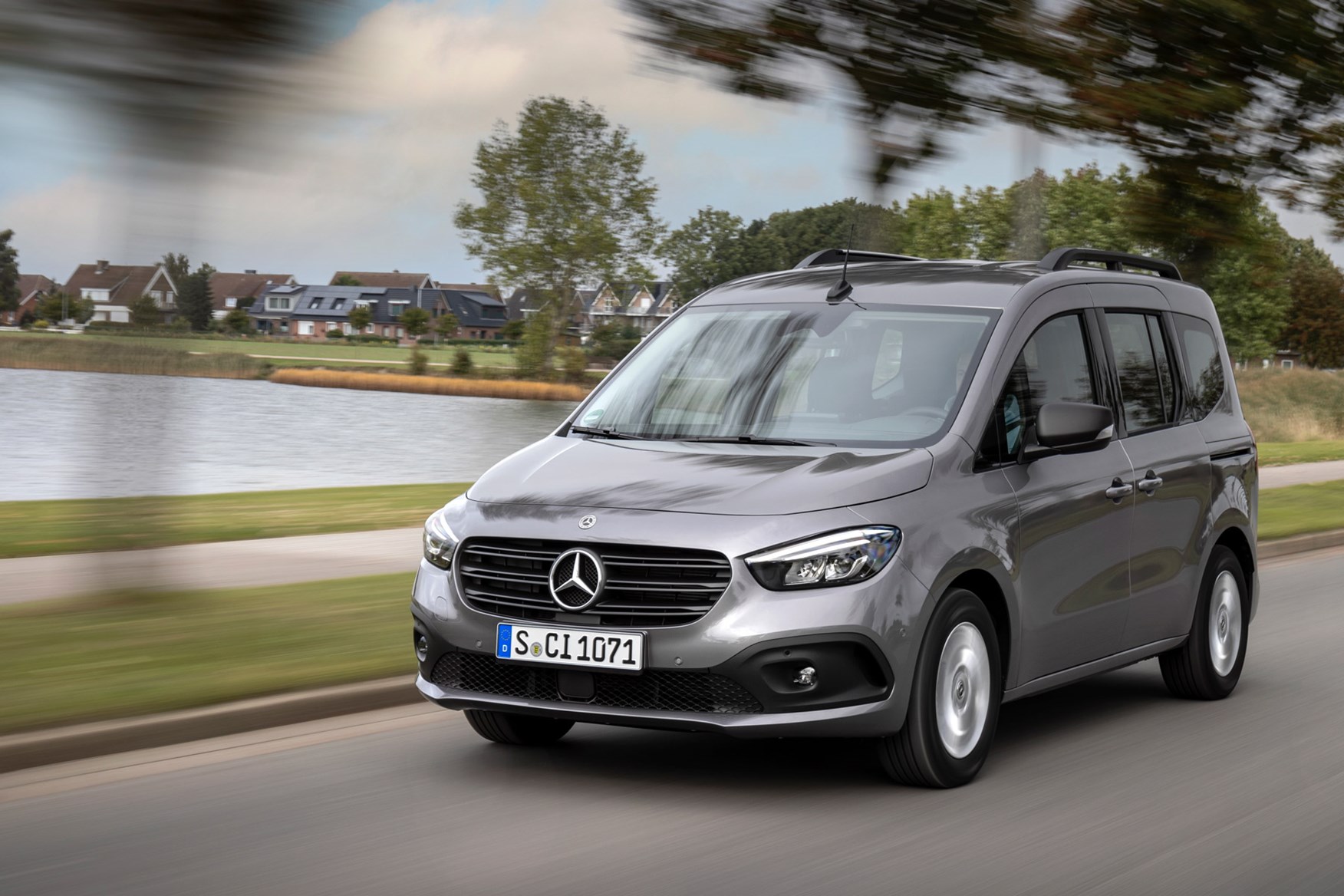
The Citan Tourer models have suspension tuned for lighter loads to make an even better fist of passenger comfort, and we found this to work very well, too. With the extra seats and carpeting, the Tourer feels very much car-quality to drive, and frankly the regular panel van isn’t far off this either.
The slightly uncouth engine noise aside, both exude a real sense of quality to the way they’ve been put together that feels well up to the standards of Mercedes brand. A far cry from the previous Citan model.
- Almost entirely Mercedes inside
- High quality fit and finish
- Good range of adjustment
If you were worried the second-generation Citan would again suffer from a Renault interior with a few bits of Mercedes switchgear crammed in you can relax. While there are some elements shared between the two – such as the inner door handles – the entire dashboard is different in the Citan and thoroughly Mercedes with it. Including plenty of parts familiar from the Sprinter and the firm’s passenger car range.
The design and material people have been pretty clever here. Whether or not you think the dashboard looks like a wing, as Mercedes would have it, matters little compared with how well the hard plastics have been disguised. For though most of the surfaces are quite hard, they don’t look cheap or nasty at all.
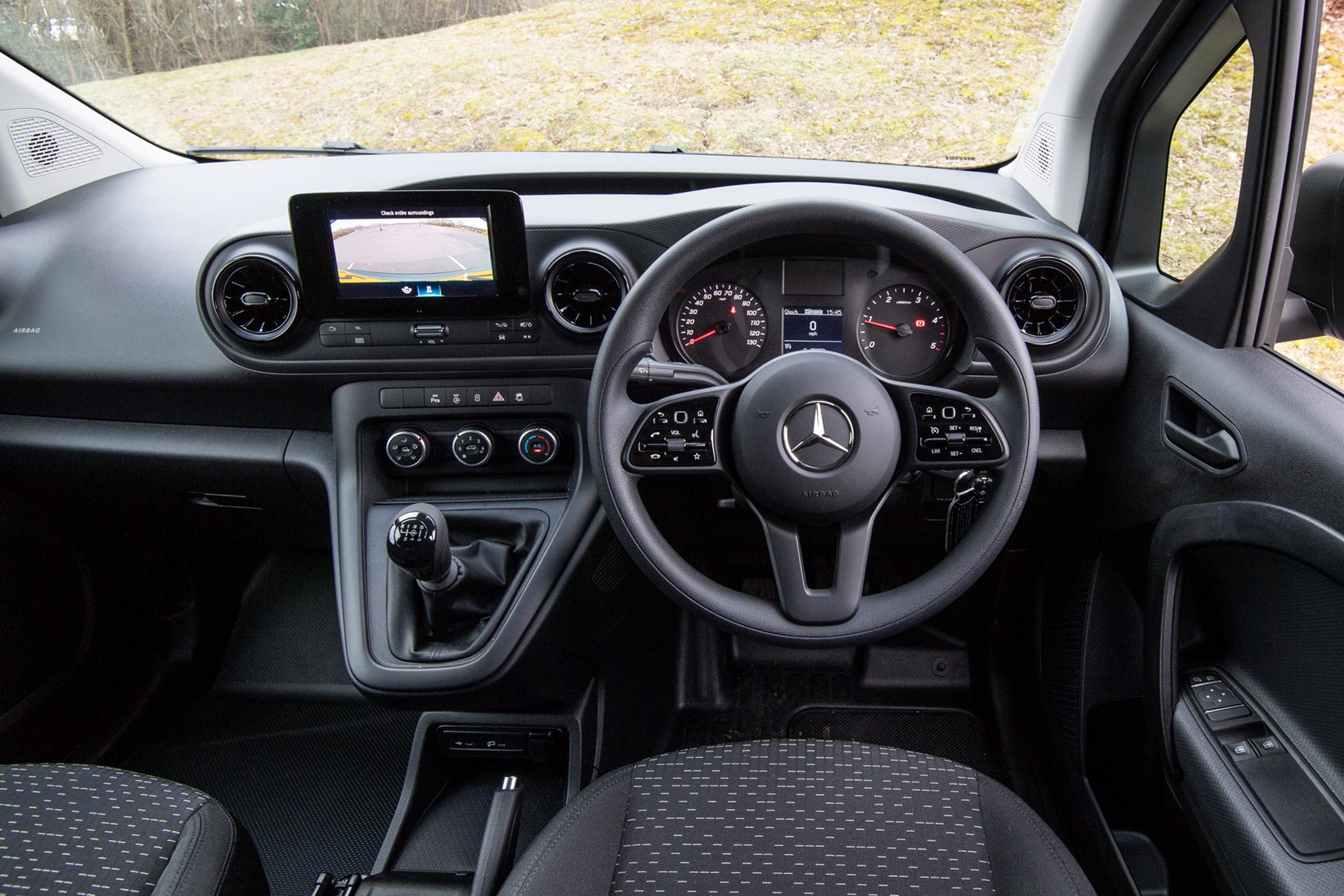
Together with the solid way the entire cabin has been put together, the Citan seems less like a small van and more like a small car – and a good one, at that.
Especially when specified with the MBUX infotainment system and digital screen in the instrument cluster (standard-fit on the Tourer, optional for the panel van). Not to mention the particularly fancy air-conditioning controls with individual digital displays within the dials.
Does that mean it’s not very practical?
Gladly, Mercedes has put plenty of thought into practicality as well. The door bins can hold 1.5-litre bottles, and there’s lidded storage available on top of the dashboard and under the (optional) centre armrest.
You can also specify a folding metal-mesh bulkhead and fold-flat passenger seat if you need to carry longer loads. Though there are surely better small van choices if that is important.
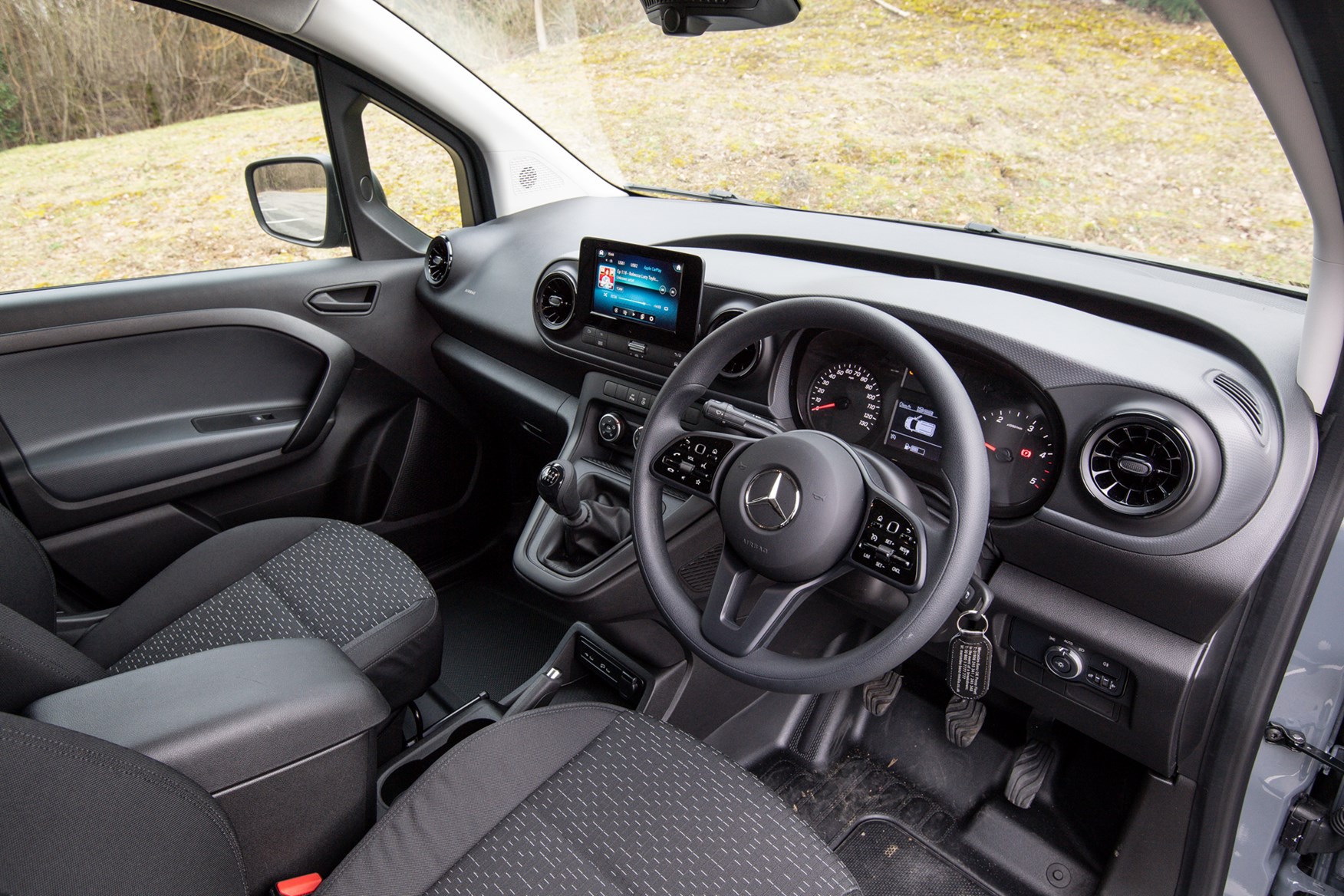
The fixed bulkhead is available with windows if you want to be able to see out of the back, while the Tourer is spacious enough for four adults, if a bit of a squeeze for five.
The front doors open to a full 90 degrees for access, too. An unusual but welcome feature.
How’s the driving position?
There is a large amount of adjustment in the reach and rake of the steering wheel, so that shouldn’t be a problem. The gearlever is mounted high in the middle of the dashboard for ease, if not quite as close to the wheel as some vans manage.
There are several grades of seat to choose from. With even the standard items featuring height and lumbar adjustment for the driver, they seem both tough and comfortable.
However, in the panel van taller drivers may struggle to get the seat back far enough. At 5’11”, this tester was up against the bulkhead.
- Pricing starts at just over £21,000
- Engine capable of a claimed 54.3mpg
The Mercedes Citan first appeared in the UK in 2023. This is slightly later than Mercedes hoped, but is down to pressures on the industry as a whole and not just the brand. Pricing starts at £21,310, which is notably more than the Renault Kangoo, but the Citan offers significantly more equipment and doesn't come with the petrol engines that take the price down in the Renault's case.
There are two trim levels to choose between, named Progressive and Premium. Upgrading to the higher of the two trims will add just under £2,000 to the price, taking it to £23,285. Going for the longer version adds £1,325.
Mercedes-Benz Citan mpg
Here are the official fuel economy figures for the Citan:
- Citan 110 CDI diesel: 54.3mpg
The range consists of just the one diesel engine for now, but there are other options available to Mercedes, so this might not always be the case.
Mercedes-Benz Citan warranty
Mercedes vans all come with three-year unlimited mileage warranties.
Mercedes-Benz Citan standard equipment
The two trims in the UK are called Progressive and Premium, with the following kit offered as standard on each model:
Progressive:
- Air conditioning
- Heat insulating glass
- LED interior lighting
- Multifunction steering wheel
- Heated and powered door mirrors
- Rear parking sensors and reversing camera
- MBUX infotainment system with smartphone integration
- Cruise control
- Body colour door handles
- 16-inch steel wheels with five-spoke trims
Premium:
- Body coloured bumpers
- Metallic paint
- 10-spoke alloy wheels
- Gloss black and chrome interior details
- Highbeam assist LED headlights and LED fog lights
As a relatively new van that’s only just gone on sale in the UK, we can’t yet gauge the second-generation Mercedes Citan’s reliability.
However, Mercedes is noted as a reliable brand in general in the annual FN50 van reliability survey, and regularly finishes right up the top - the Mercedes' larger van, the Sprinter, has been named the most reliable in the listings for several years now. Although much of the Citan is based on Renault technology, Mercedes' reputation for high-quality aftercare should see you right whatever happens.
- At least six airbags as standard
- Autonomous emergency braking also fitted
Every Citan comes with a high level of safety equipment by van standards. While most manufacturers only fit a single airbag, the Citan comes with six airbags as standard. Citan Tourer models have seven airbags as standard, the extra item being a centre airbag to stop driver and passenger colliding.
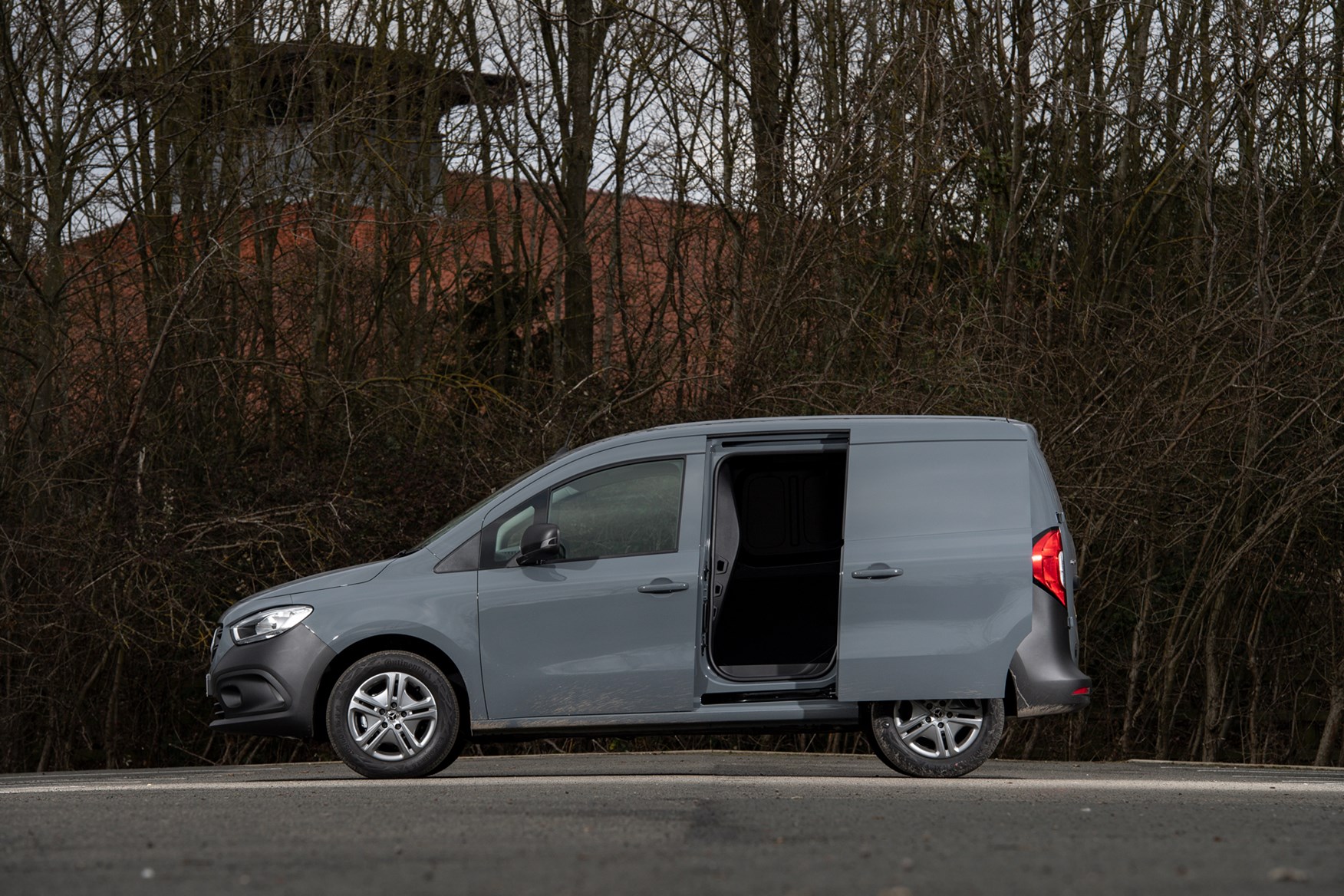
Other standard features include ABS and electronic stability control – as legally required – plus hill-start assist, crosswind assist and attention assist (which watches out for driver fatigue) on the panel van models. Autonomous emergency braking (Active Brake Assist) is also included on every model, while active lane-keeping assist, blindspot monitors and speed limit assist are all offered as options
Which Mercedes-Benz Citan is best for me?
The standard equipment on the Citan means that there is no real reason to step up to the Premium model, unless you want to that is. Lots of the basics that you often miss out on - air conditioning, multiple airbags and electric windows - all come included, as do a few that are often seen as luxuries such as cruise control and the MBUX screen with smartphone mirroring to act as a sat nav.





























